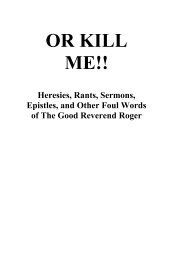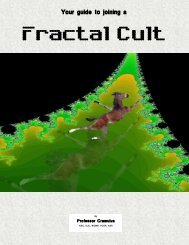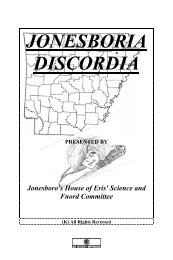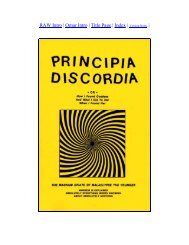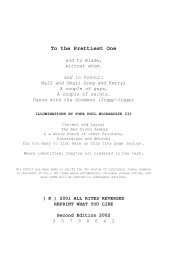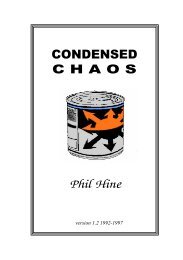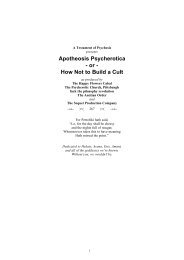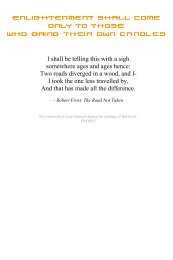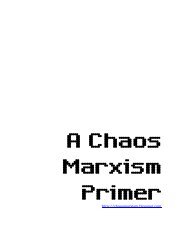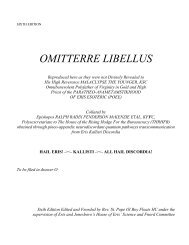Coincidance - Principia Discordia
Coincidance - Principia Discordia
Coincidance - Principia Discordia
You also want an ePaper? Increase the reach of your titles
YUMPU automatically turns print PDFs into web optimized ePapers that Google loves.
172 COINCIDANCE<br />
"Micholas de Cusack" conflates Nicholas of Cusa with Michael Cusack, a<br />
notorious anti-semitic nationalist of the Dublin of Joyce's day (who,<br />
incidentally, was the model for The Citizen in Ulysses). Since Mick and Nick<br />
in FW are usually opposites of the variety—they are, in fact, most<br />
often the Archangel Michael and Satan, or the duality as cosmic<br />
principle in Christian mythology—this Mick/Nick unity ( ) is itself a<br />
"coincidance of contraries." The brown candlestock that melts Nolans is<br />
Bruno of Nola ( ) divided into contraries ( ). The Baxters and<br />
Fleshmans are a variation on the Bakers and Butchers who run all through<br />
FW; these are extensions of Cain ( ) the tiller of fields and hence an<br />
ancestor of Bakers, and Abel ( ) keeper of herds and an ancestor of<br />
butchers. The sequence butcher-baker-candlestock invokes a familiar trio of<br />
childhood lore, the butcher, the baker and the candlestick maker, another of<br />
Joyce's trios ( ) that emerge from a duo ( ) .<br />
The O'Loughlins, meanwhile, are an Anglicized version of the older<br />
Gaelic tribe correctly spelled O'Lachlann. This means "son of the Dane," and<br />
brings us back to Hamlet, Prince of Demnark; but that should not surprise<br />
us because the butchers in FW always are in "coincidance" with both Abel<br />
and Shakespeare, who worked as a butcher in his youth and had a butcher<br />
as a father. What does seem strange to me is that this pivotal passage should<br />
directly involve my own family, because my grandmother was an O'Lachlann.<br />
(But then Stan Gebler Davies, who wrote a biography of Joyce while living,<br />
unknowingly, in the same building with Morris Ernst, the lawyer who<br />
convinced an American court that Ulysses was not obscene, points out that<br />
coincidence haunts all commentators who get involved with Joyce.)<br />
The O'Lachlanns or O'Loughlins are said to be descended from Olaf the<br />
White, King of the Isle of Man in the 9th Century. This Olaf links directly to<br />
Hamlet, because, as C'Hehir has documented, Olaf became Amhlain in<br />
Gaelic and it was from this that Saxo-Germanicus developed the further<br />
"corruption" which became the Hamlet we know. We have already indicated<br />
that the same root gave us the Humphrey that is our dreamer's first name.<br />
The Fleshmans as butchers also tips a hat to Martha Fleishmann, a young<br />
lady with whom Joyce had a brief affair in 1917, and who previously got into<br />
his works as the mysterious "Martha Clifford" in Ulysses. Bloom, you may<br />
recall, corresponded with her under the pen-name, "Henry Flower." That<br />
was actually the name of a Dublin policeman who was suspected of murder<br />
in 1902, never brought to trial because of lack of evidence, and finally left<br />
Dublin because gossip continued to accuse him. In the Cyclops chapter of<br />
Ulysses, it is Michael Cusack, called only The Citizen, who appears as the only<br />
overt anti-semite in the book and threatens to "crucify" Bloom. The punchline<br />
did not come until 1942, a year after Joyce's death, when an old woman<br />
in Dublin, dying, summoned a solicitor and dictated a confession. She had



